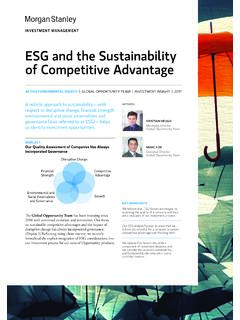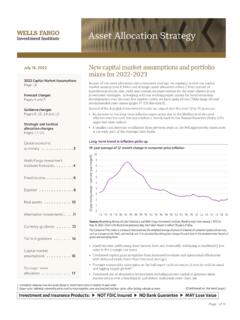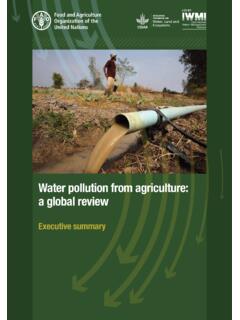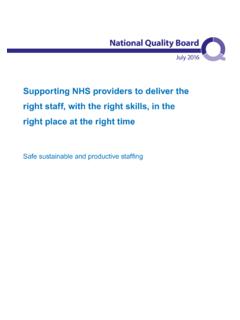Transcription of Gender equity in the health workforce: Analysis of 104 ...
1 March 2019 Gender equity in the health workforce: Analysis of 104 countriesMathieu Boniol, Michelle McIsaac, Lihui Xu, Tana Wuliji, Khassoum Diallo, Jim CampbellHealth Workforce Working paper 1 WORKING PAPER 1 WHO/HIS/HWF/ Gender /WP1 World health Organization 2019 Some rights reserved. This work is available under the Creative Commons Attribution-NonCommercial-ShareAlike IGO licence (CC BY-NC-SA IGO; ). Under the terms of this licence, you may copy, redistribute and adapt the work for non-commercial purposes, provided the work is appropriately cited, as indicated below. In any use of this work, there should be no suggestion that WHO endorses any specific organization, products or services. The use of the WHO logo is not permitted. If you adapt the work, then you must license your work under the same or equivalent Creative Commons licence.
2 If you create a translation of this work, you should add the following disclaimer along with the suggested citation: This translation was not created by the World health Organization (WHO). WHO is not responsible for the content or accuracy of this translation. The original English edition shall be the binding and authentic edition . Any mediation relating to disputes arising under the licence shall be conducted in accordance with the mediation rules of the World Intellectual Property citation. Boniol M, McIsaac M, Xu L, Wuliji T, Diallo K, Campbell J. Gender equity in the health workforce: Analysis of 104 countries. Working paper 1. Geneva: World health Organization; 2019 (WHO/HIS/HWF/ Gender /WP1 ).Licence: CC BY-NC-SA (CIP) data. CIP data are available at , rights and purchase WHO publications, see To submit requests for commercial use and queries on rights and licensing, see Third-party materials.
3 If you wish to reuse material from this work that is attributed to a third party, such as tables, figures or images, it is your responsibility to determine whether permission is needed for that reuse and to obtain permission from the copyright holder. The risk of claims resulting from infringement of any third-party-owned component in the work rests solely with the disclaimers. The designations employed and the presentation of the material in this publication do not imply the expression of any opinion whatsoever on the part of WHO concerning the legal status of any country, territory, city or area or of its authorities, or concerning the delimitation of its frontiers or boundaries. Dotted and dashed lines on maps represent approximate border lines for which there may not yet be full mention of specific companies or of certain manufacturers products does not imply that they are endorsed or recommended by WHO in preference to others of a similar nature that are not mentioned.
4 Errors and omissions excepted, the names of proprietary products are distinguished by initial capital reasonable precautions have been taken by WHO to verify the information contained in this publication. However, the published material is being distributed without warranty of any kind, either expressed or implied. The responsibility for the interpretation and use of the material lies with the reader. In no event shall WHO be liable for damages arising from its use. The named authors alone are responsible for the views expressed in this and layout by L IV Com S rl, SwitzerlandPrinted by the WHO Document Production Services, SwitzerlandAcknowledgementsThe present working paper was prepared by the WHO health Workforce Department under the coordination of Mathieu Boniol, with contributions from Jim Campbell, Khassoum Diallo, Michelle McIsaac, Tana Wuliji and Lihui Xu.
5 The authors would like to acknowledge Sonali Reddy for the production Working paper 1 WORKING PAPER 1 Gender equity in the health workforce: Analysis of 104 countriesKey messages1 Women form 70% of workers in the health and social sector. Women s representation in the most highly paid health occupations has been improving steadily since 2000. Women are less likely than men to be in full-time employment. Overall, an average Gender pay gap of around 28% exists in the health workforce. Once occupation and working hours are accounted for, the Gender pay gap is 11%. Although the sector performs well regarding women s participation, Gender transformative policies are needed to address inequities and eliminate Gender -based discrimination in earnings, remove barriers to access to full-time employment, and support access to professional development and leadership roles.
6 Gender equity in the health workforce: Analysis of 104 countries2 BackgroundThe health and social sector, with its 234 million workers, is one of the biggest and fastest growing employers in the world, particularly of Women comprise seven out of ten health and social care workers and contribute US$ 3 trillion annually to global health , half in the form of unpaid care in the health and social workforce undermines the prospects of achieving the sustainable Development Goals (SDGs). The WHO SDG health price tag study finds that almost half of the investment required to achieve the health SDGs relates to education, training and employment of health workers. The WHO Global Strategy on Human Resources for health : Workforce 2030 (GSHRH) estimates a global shortfall of almost 18 million health workers by 2030, primarily in low- and lower middle income The GSHRH also calls for strengthening data and progressive implementation of National health Workforce Accounts (NHWA).
7 Investing in the health and social workforce not only contributes to the achievement of universal health coverage and to global health security, but, as the United Nations Secretary-General s High-Level Commission on health Employment and Economic Growth found, investments in the health and social workforce have a powerful multiplier effect on economic growth and can contribute to maximizing women s economic empowerment and , together with the International Labour Organization (ILO) and Organisation for Economic Co-operation and Development (OECD), adopted the Working for health 1 ILO. report for discussion at the Tripartite Meeting on Improving Employment and Working Conditions in health Services. Geneva: International Labour Organization; Langer A, Meleis A, Knaul FM, Atun R, Aran M, Arreola-Omelas H et al. Women and health : the key for sustainable development.
8 Lancet. 2015;386:1165 WHO. Global Strategy on Human Resources for health : Workforce 2030. Geneva: World health Organization; United Nations High-Level Commission on health Employment and Economic Growth. Working for health and growth: investing in the health workforce. Geneva: World health Organization; in 2017, a joint inter-agency multi-SDG programme to accelerate the expansion and transformation of the health and social workforce. The programme embraces Gender as a core tenant and seeks to utilize workforce plans, investments and actions to seize the opportunities to realize the Gender dividend. In November 2017, WHO established the Global health Workforce Network which includes a Data and Evidence Hub and a Gender equity Hub, which both bring together key stakeholders for strengthening data and evidence and supporting Gender transformative actions and Gender issues have been at the top of the global agenda, few comprehensive studies on Gender in the health and social workforce have been conducted at the global level.
9 This brief is based on an Analysis of WHO NHWA data5 for 104 countries over the last 18 findingsOccupational segregation by Gender The Analysis confirms previous findings6 that women s share of employment in the health and social sector is high, with an estimated 67% of the health workforce in the 104 countries analysed being female. Nevertheless, systematic differences exist in Gender distribution by occupation across all regions. In most countries, male workers make up the majority of physicians, dentists and pharmacists in the workforce, with female workers comprising the vast majority of the nursing and midwifery workforce (Figure 1). 5 National health Workforce Accounts data include country reported indicators, OECD statistics, Labour Force Survey (LFS) data compiled by ILO, census data compiled by the Minnesota Population Center in their Integrated Public Use Microdata Series (IPUMS).
10 6 Magar V, Gerecke M, Dhillon IS, Campbell J. Women s contributions to sustainable development through work in health : using a Gender lens to advance a transformative 2030 agenda. In: Buchan J, Dhillon IS, Campbell J, editors. health employment and economic growth: an evidence base. Geneva: World health Organization; 2017 ( , accessed 6 March 2019).3 Working paper 1 Women s representation in the health sector has increased over time, particularly among the higher wage health care occupations ( physicians, dentists and pharmacists). In OECD countries, the share of female physicians between 2000 and 2017 increased by 13% (an average by annually). The Labour Force Surveys (LFS) data from FIGURE 1. Distribution of physicians and nurses by Gender Female MaleAfrican Region28%72%Region of the Americas46%54%Eastern Mediterranean Region35%65%European Region53%47%South-East Asia Region39%61%Western Pacific Region41%59% Female MalePhysicians: percentage of female and maleAfrican Region65%35%Region of the Americas86%14%Eastern Mediterranean Region79%21%European Region84%16%South-East Asia Region79%21%Western Pacific Region81%19%Nurses: percentage of female and maleSource: Data from NHWA for 91 countries for physician data and 61 countries for nursing countries confirm this trend.















